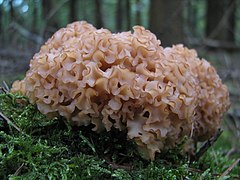Sparassidaceae
| Sparassidaceae | |
|---|---|

| |
| Sparassis crispa, edible member of the Sparassidaceae | |
| Scientific classification | |
| Kingdom: | |
| Division: | |
| Class: | |
| Order: | |
| Family: | Sparassidaceae Herter (1910)
|
| Type genus | |
| Sparassis Fr. (1819)
| |
| Genera | |
The Sparassidaceae are a family of fungi in the order Polyporales. The family was circumscribed by German botanist Wilhelm Herter in 1910 to contain the genus Sparassis.[1] Sparassiella was added to the family in 1964.[2] As of April 2018[update], Index Fungorum accepts 10 species in the Sparassidaceae.[3]
Description[edit]
The fruit bodies of Sparassidaceae fungi consist of branched, fan-shaped segments that originate from a central core. The hyphal system is monomitic, with gloeoplerous hyphae (containing oil droplets). These hyphae have scattered clamp connections. The spores are smooth, thin- to somewhat thick-walled, and hyaline (translucent). Cystidia are mostly absent from the hymenium. Sparassidaceae fungi cause brown rot.[4]
References[edit]
- ^ Herter, W.G.F. (1910). Autobasidiomycetes. Kryptogamen-Flora der Mark Brandenburg (in German). Vol. 6. p. 167.
- ^ Schwarzman, S.R. (1964). Flora Sporowich Rastenii Kazachstana, Tom. IV: Auriculariales, Tremellales, Dacryomycetales, Exobasidiales, Aphyllophorales. p. 159.
- ^ Kirk, P.M. (ed.). "Species Fungorum (version 28th March 2018). In: Species 2000 & ITIS Catalogue of Life". Archived from the original on 9 April 2018. Retrieved 9 April 2018.
- ^ Justo, Alfredo; Miettinen, Otto; Floudas, Dimitrios; Ortiz-Santana, Beatriz; Sjökvist, Elisabet; Lindner, Daniel; Nakasone, Karen; Niemelä, Tuomo; Larsson, Karl-Henrik; Ryvarden, Leif; Hibbett, David S. (2017). "A revised family-level classification of the Polyporales (Basidiomycota)". Fungal Biology. 121 (9): 798–824. doi:10.1016/j.funbio.2017.05.010. PMID 28800851.
